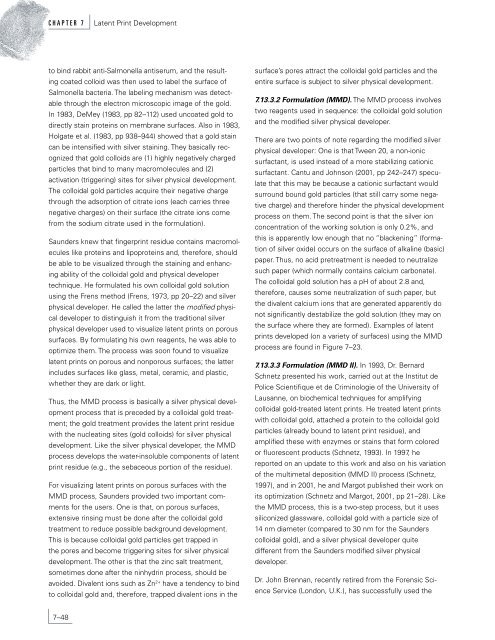Latent Print Development - National Criminal Justice Reference ...
Latent Print Development - National Criminal Justice Reference ...
Latent Print Development - National Criminal Justice Reference ...
You also want an ePaper? Increase the reach of your titles
YUMPU automatically turns print PDFs into web optimized ePapers that Google loves.
C H A P T E R 7 <strong>Latent</strong> <strong>Print</strong> <strong>Development</strong><br />
to bind rabbit anti-Salmonella antiserum, and the resulting<br />
coated colloid was then used to label the surface of<br />
Salmonella bacteria. The labeling mechanism was detectable<br />
through the electron microscopic image of the gold.<br />
In 1983, DeMey (1983, pp 82–112) used uncoated gold to<br />
directly stain proteins on membrane surfaces. Also in 1983,<br />
Holgate et al. (1983, pp 938–944) showed that a gold stain<br />
can be intensified with silver staining. They basically recognized<br />
that gold colloids are (1) highly negatively charged<br />
particles that bind to many macromolecules and (2)<br />
activation (triggering) sites for silver physical development.<br />
The colloidal gold particles acquire their negative charge<br />
through the adsorption of citrate ions (each carries three<br />
negative charges) on their surface (the citrate ions come<br />
from the sodium citrate used in the formulation).<br />
Saunders knew that fingerprint residue contains macromolecules<br />
like proteins and lipoproteins and, therefore, should<br />
be able to be visualized through the staining and enhancing<br />
ability of the colloidal gold and physical developer<br />
technique. He formulated his own colloidal gold solution<br />
using the Frens method (Frens, 1973, pp 20–22) and silver<br />
physical developer. He called the latter the modified physical<br />
developer to distinguish it from the traditional silver<br />
physical developer used to visualize latent prints on porous<br />
surfaces. By formulating his own reagents, he was able to<br />
optimize them. The process was soon found to visualize<br />
latent prints on porous and nonporous surfaces; the latter<br />
includes surfaces like glass, metal, ceramic, and plastic,<br />
whether they are dark or light.<br />
Thus, the MMD process is basically a silver physical development<br />
process that is preceded by a colloidal gold treatment;<br />
the gold treatment provides the latent print residue<br />
with the nucleating sites (gold colloids) for silver physical<br />
development. Like the silver physical developer, the MMD<br />
process develops the water-insoluble components of latent<br />
print residue (e.g., the sebaceous portion of the residue).<br />
For visualizing latent prints on porous surfaces with the<br />
MMD process, Saunders provided two important comments<br />
for the users. One is that, on porous surfaces,<br />
extensive rinsing must be done after the colloidal gold<br />
treatment to reduce possible background development.<br />
This is because colloidal gold particles get trapped in<br />
the pores and become triggering sites for silver physical<br />
development. The other is that the zinc salt treatment,<br />
sometimes done after the ninhydrin process, should be<br />
avoided. Divalent ions such as Zn2+ have a tendency to bind<br />
to colloidal gold and, therefore, trapped divalent ions in the<br />
7–48<br />
surface’s pores attract the colloidal gold particles and the<br />
entire surface is subject to silver physical development.<br />
7.13.3.2 Formulation (MMD). The MMD process involves<br />
two reagents used in sequence: the colloidal gold solution<br />
and the modified silver physical developer.<br />
There are two points of note regarding the modified silver<br />
physical developer: One is that Tween 20, a non-ionic<br />
surfactant, is used instead of a more stabilizing cationic<br />
surfactant. Cantu and Johnson (2001, pp 242–247) speculate<br />
that this may be because a cationic surfactant would<br />
surround bound gold particles (that still carry some negative<br />
charge) and therefore hinder the physical development<br />
process on them. The second point is that the silver ion<br />
concentration of the working solution is only 0.2%, and<br />
this is apparently low enough that no “blackening” (formation<br />
of silver oxide) occurs on the surface of alkaline (basic)<br />
paper. Thus, no acid pretreatment is needed to neutralize<br />
such paper (which normally contains calcium carbonate).<br />
The colloidal gold solution has a pH of about 2.8 and,<br />
therefore, causes some neutralization of such paper, but<br />
the divalent calcium ions that are generated apparently do<br />
not significantly destabilize the gold solution (they may on<br />
the surface where they are formed). Examples of latent<br />
prints developed (on a variety of surfaces) using the MMD<br />
process are found in Figure 7–23.<br />
7.13.3.3 Formulation (MMD II). In 1993, Dr. Bernard<br />
Schnetz presented his work, carried out at the Institut de<br />
Police Scientifique et de Criminologie of the University of<br />
Lausanne, on biochemical techniques for amplifying<br />
colloidal gold-treated latent prints. He treated latent prints<br />
with colloidal gold, attached a protein to the colloidal gold<br />
particles (already bound to latent print residue), and<br />
amplified these with enzymes or stains that form colored<br />
or fluorescent products (Schnetz, 1993). In 1997, he<br />
reported on an update to this work and also on his variation<br />
of the multimetal deposition (MMD II) process (Schnetz,<br />
1997), and in 2001, he and Margot published their work on<br />
its optimization (Schnetz and Margot, 2001, pp 21–28). Like<br />
the MMD process, this is a two-step process, but it uses<br />
siliconized glassware, colloidal gold with a particle size of<br />
14 nm diameter (compared to 30 nm for the Saunders<br />
colloidal gold), and a silver physical developer quite<br />
different from the Saunders modified silver physical<br />
developer.<br />
Dr. John Brennan, recently retired from the Forensic Science<br />
Service (London, U.K.), has successfully used the

















